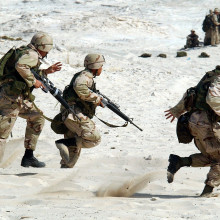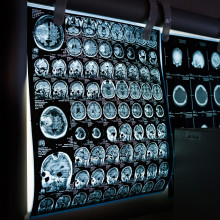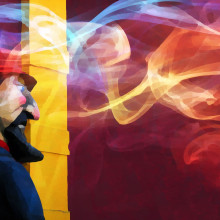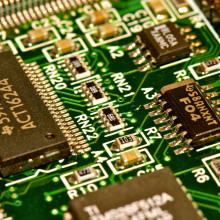Today, we’re taking a closer look at traumatic brain injuries, TBIs. We’ll be hearing from the doctors who are treating them, and a former soldier who is suffering from a host of mental health conditions as a consequence of his military service.
And a bit later on, we'll find out how scientists are harnessing the incredible efficiency of our brains to break new ground in computing performance…
In this episode

01:13 - US veteran describes life with a brain injury
US veteran describes life with a brain injury
What is it like to live with a TBI? Sean served for 27 years as a marine in the US army. Concussions and head knocks can happen to anyone, but they are particularly common in the military, and can inflict wounds that aren’t always immediately apparent…
Sean - I can't put my finger on an exact moment when I can say a TBI happened. But, as a Forward Air Controller, I dropped 99 bombs from the air. For most of those we were in within inside of what was called danger close, so inside the blast radius of the bomb. And so that impact, I really believe, is the most devastating impact because you can imagine a soft brain inside of a hard shell, skull getting racked around by the overpressure from a bomb - I'd say 40 or 50 of those I was well within inside the blast radius. I think that rung my bell a number of times and created some injury. I was in the back of what was called a deuce and a half, a large, transport truck that got hit by an IED and fell off the side and saw stars and all that kind of thing. So a number of very specific instances, but generally it's a prolonged exposure.
James - I see. So it's fair to say, in your personal experience, there's no one big KO you can recall to, it's more a series of more mild ones, which we know now can have this cumulative effect.
Sean - Absolutely. And as I got out of the military, our Veterans Administration, our VA, does a profile. They were looking for very specific concussive [symptoms]: lost memory, lost sight, you were out cold, those kinds of things. But I couldn't answer those questions and so wasn't specifically diagnosed with TBI, but I believe that, quite honestly, most of the guys that I've gone through this programme with, they feel it's the same thing: it's that prolonged exposure, the number of different weapon systems that we go off that are very loud and concussive.
James - And at what point did you start to consider that TBI might be what you were suffering from in the years following?
Sean - Well, I took the advice of the VA and I followed as many of the different protocols that they offered and had a disability designation by the VA of PTSD. When you're a leader, you just file that back in your backpack and say, 'I can deal with this.' So I kind of dealt with it for a number of years. It was over a period of a number of different things happening in my life that really created high stress that, that I actually started reaching out and talking to some other friends that were going through some things. It was in about my mid forties that I started noticing a significant memory loss. I couldn't recall things or I couldn't even remember names of people that I knew pretty well. Obviously the ones I knew really well, I did, but it was really that memory loss plus not being able to handle some of the stress so that I thought, maybe there was something else going on.
James - I see. So the memory loss combined with those neuropsychiatric conditions. You mentioned PTSD, did you receive any treatment?
Sean - Yeah. I volunteered at the VA for a number of them. I went through speaking with psychologists and therapists, went through a mindfulness programme, and none of them really seemed to help. Even a psychiatrist who ordered up Zoloft which, as you can imagine, any of us that are on the front lines, you have your super aggression and your high activity, and we kind of thrive on that. The Zoloft just made me feel like I was numbing out. So I went through a number of types of therapy, and none of them seemed to work.
James - So is that what gave you the impetus to seek alternative treatment?
Sean - Well, actually, like I said, as a leader, an officer, you tend to think 'I'm fine, I'm fine,' and you file it back in your backpack and, at some point, the backpack gets too heavy to carry. I had gone through a period where, starting in 2017, my son committed suicide, that led to a divorce, shortly after that, within about a year or two, lost a job and then, decided to go build my own business, got into a property transaction that didn't work out. I lost about $650,000. You can see, all these things were building up so that I finally realised I couldn't do it on my own. So I reached out to a couple other friends from the military, and I saw a change in what they were going through and was like, 'okay, there's something different here.' So I started talking to them and they said, 'Oh, yeah, we went through this treatment, this therapy, and it just changed my life. And so I thought, I'm not really sure about it. It was a psychedelic therapy that they were describing and I have never taken a drug in my life. I'm not really into the whole psychedelic thing. That's a little creepy. Then, about three years ago, I would wake up every morning with a sheer dread, just an unimaginable amount of anxiety and dread where I actually had formulated a suicide plan. It would last about an hour in the morning, I'd go take a shower and try to shake it off, and then I'd realise, that's not me. And then I'd go about my day and then, again, the next morning, same thing all over again. At some point in there I said, 'I can't. Something's wrong with me, and it's noticeably not me. There's something inside that's off.' That's when I started to look at what the options were and started to talk a little bit more to my friends that had been through this medicine and this psychedelic therapy.

08:23 - Providing better care for TBI patients
Providing better care for TBI patients
Julie-Anne Fulford, Help for Heroes
Former Staff Sergeant Julie-Anne Fulford completed two tours of Afghanistan during her 16 years of service in the British army and is now a member of the clinical team at the military veterans charity, Help for Heroes. She oversees the care of many veterans with TBIs...
Julie-Anne - The big thing with brain injuries is, there's nothing you can do about the initial brain injury. The biggest thing in the very short term, the acute phase, is to prevent the secondary brain injury. You have your brain, cerebrospinal fluid - which is the fluid that cushions the brain - and blood. If one of those things increases, then the other has to decrease. We really worry about the pressure inside the brain. In the very early stages, a lot of the interventions that happen are very small. It's a very long period of time before you start to see any big changes.
James - You mentioned earlier TBIs, they disrupt the functioning of the brain. What does that look like over the medium to long term? What can it look like?
Julie-Anne - It can be very interchangeable. It's quite easy to recognise when somebody's had a massive brain injury because often you'll be able to see this physical disability, their speech might be impaired, there's easier things to spot. What we sometimes start with is a patient who can be very agitated, confused, and often quite different to the person that they were before. A lot of my veterans were injured when they were really young, so it's almost like the brain has stopped and the last thing they remember is being that 26, 27-year-old, young soldier, sailor, airman, airwoman. Then, we are picking up the pieces from there and trying to help them now become the person that they are post-injury.
James - Looking at mild TBIs, these can be quite difficult sometimes to even recognise they've happened, can't they? It's more obvious when someone's had a moderate to severe one, their trauma's more extreme, but the mild ones can be difficult to diagnose but still play a part in long-term health consequences.
Julie-Anne - I look at these as like the walking wounded or the silent sick. Sometimes mild brain injuries often are diagnosed late because they don't show up on scans and it's often other practitioners that might pick up on it like your occupational therapists, your physiotherapists, or somebody who's involved, family members, because they're not quite acting the way that they used to act. Often, with brain injuries, people can be perceived as being aggressive or having anger issues, but most of the cases I see there isn't anger, it's anxiety, it's them not understanding how to explain to people that they do have a brain injury.
James - I wonder if you could go into some detail on the mental health conditions like anxiety, depression and PTSD that people might suffer as a result of a TBI?
Julie-Anne - Many of our veterans will have sustained their traumatic brain injuries in unusual traumatic circumstances. On the whole, the population, civilian and military, about 6% suffer PTSD. So we're quite balanced in that respect. However, the trigger is different. A lot of our veterans, the last thing they will remember from their injury is, say, being out on patrol, being out on the ground with their friends, and then this catastrophic event happening and then waking up back in the UK thinking, what's happened to me? Where am I? And trying to reexamine their lives. Some of the anxiety and depression, what we have to remember is people join the military because often they want the excitement or they want a challenge. When they sustain an injury, their lives completely change. That's a huge shock and a huge adjustment. So I think that has a lot to play with the anxiety and depression side of things.
James - I suppose that could be a theory as to why, as I understand it, some of the mainstream treatments for conditions like anxiety, depression and PTSD, so things like antidepressants or cognitive behavioural therapy, CBT, they seem to be less effective treatments when applied to military veterans who've acquired those conditions as a result of TBIs.
Julie-Anne - Yeah, I think the big thing is recognising what the issue is. As I said, there's nothing we can do about the initial brain injury, but what's really important is understanding what the trigger is, what's triggering the anxiety, what's triggering the depression. Is that what the veteran remembers from the situation? Is it the loss, the grief, that they've sustained? Not just losing a friend, loss of who they are. I think what works really well for veterans is the holistic approach, ensuring that everyone's involved who can be within their care. A huge part of the treatment is getting the individual to accept that they might not necessarily ever get back to their pre-injury state and then allowing them to understand what's left and how we can utilise that to help them move forward.

13:49 - Macrophages provide a marker for mild TBI diagnosis
Macrophages provide a marker for mild TBI diagnosis
Samir Mitragotri, Harvard University
TBI diagnostics are still pretty rudimentary. MRI scans are useful for spotting structural changes to the brain - lesions, for example, which might be an indication of severe TBI - but fail to detect the more subtle changes in brain functionality associated with mild traumatic brain injury.
A team of researchers at Harvard University have been working on a solution. Using part of the body’s immune response to head trauma, they’ve found a biomarker which they can take advantage of to ensure fewer mild TBIs go undiagnosed. They’re called macrophages. Professor Samir Mitragotri explains…
Samir - So macrophages are the body's immune cells. They are among the most common immune cells, and what is unique about them is that whenever there is damage or inflammation in tissue, they infiltrate into the tissue and they become a part of the tissue. We figured that even though the trauma may be subtle, that the structure will not be visibly changed, the macrophages may know that the trauma has happened and may infiltrate into the brain and maybe we can use that signal to detect the extent of trauma.
James - Could they be getting to the brain for any other reason other than a TBI?
Samir - That's quite possible. Macrophages chase inflammation. If there are other reasons to go into the brain, they very well might. But in the case of TBI, if we suspect that the brain has suffered a trauma, which is typically what happens when you bring in a subject: because a fall has happened, a trauma has happened, in that case, if you see the inflammation, if you see the macrophages going into the brain, that is a good way to see whether the trauma has happened.
James - I see. Where did the idea come from to use macrophages in TBI diagnostics? What was the leap there?
Samir - So the leap to use macrophages really comes from the physiology. The challenge has been how do you see them? They're not visible under MRI. We wanted to attach a contrast agent to them so that we can track these macrophages. That turned out to be quite a challenge because macrophages are the bodies professional eaters, they will basically eat whatever they bind to. In fact, that's their job. So how do you attach something to the macrophage without having it eaten by the macrophage? We had made a discovery a while ago that macrophages cannot internalise disc shaped particles when they bind to them. So we figured out a way to make a disc shaped backpack and we put gadolinium in it.
James - This is gadolinium, a commonly used contrast agent, a substance which will light up on an MRI like a Christmas tree, which you were able to put in the disc shaped hydrogel backpack you developed worn by macrophages as they travel to the brain to fight inflammation from a mild TBI.
Samir - Indeed. And that's what we call a GLAM, which is basically a micron sized hydrogel disc that is loaded with a high concentration of gadolinium, and that becomes our tracker of the macrophage, wherever it is in the body. Gadolinium is a small molecule entity, so when you inject in the blood, it is cleared pretty quickly, within minutes from the body. And in fact, it is cleared by kidney filtration. That's been one of the challenges. Those patients who may be suffering from kidney malfunctioning, they cannot really use the current version of gadolinium very effectively. So when it came to putting gadolinium in our backpacks, two constraints had to be met: one is that gadolinium needs to make contact with water because that's the mechanism by which it provides a contrast. So to allow the water molecules to come in close contact with gadolinium, we went with the hydrogel design for the backpack. It's very porous so water molecules can come in. And the second design factor was that because hydrogels are porous, gadolinium can potentially leak out. To stop that from happening, we covalently conjugated gadolinium to the backpack. And to make that happen, we had to make a special version of the gadolinium molecule which can be incorporated into the backpack. By doing these two modifications, we were able to make backpacks which can provide a strong enough contrast in MRI.
James - And did they work? Have you tested the effectiveness of your GLAM hitchhikers and what were the results?
Samir - They did work. So we tested the GLAMs in a pig model. That work was done in collaboration with a researcher at Boston Children's Hospital. The way this was tested is that mild TBI was induced in pigs, and when we injected these animals with GLAMs, we saw that we are able to see the occurrence of mild TBI under the conditions where the conventional gadolinium contrast could not provide an indication.
James - An incredible bit of science. Is there the potential for this sort of work to be extrapolated into other diagnostic tools for us to use the immune system to help to diagnose other diseases?
Samir - We believe so. At the heart of it, we are essentially tracking the motion of macrophages and macrophages are very sensitive indicators of inflammation and injury. So by being able to see where they are and how they're moving about, I think one can make a very sensitive and very differentiated diagnosis of many other conditions. What we have done in this study is used it to detect mild TBI, but we do believe that there is potential to extrapolate these two other indications and the research will have to be done to get a better assessment as to what those indications would be and how would this method be superior compared to the current standards for those diseases.

20:35 - Psychoactive drug ibogaine shows success with TBI vets
Psychoactive drug ibogaine shows success with TBI vets
Nolan Williams, Stanford University
As we’ve been learning, the earlier we detect mild TBIs, the more we can do for people who go on to develop neuropsychiatric conditions. But there may be hope now too for people for whom depression, anxiety and PTSD have taken hold. A new treatment - the psychoactive drug ibogaine (illegal in many countries) - has shown some promise.
I’ve been speaking to Nolan Williams who is leading research at Stanford University into the use of ibogaine to alleviate the plight of veterans suffering from the fallout of TBIs where 30 US ex special forces were treated with the drug in a clinic in Mexico...

29:31 - New hardware harnesses the computing efficiency of the brain
New hardware harnesses the computing efficiency of the brain
Domenico Vicinanza, Anglia Ruskin University
Supercomputers are the backbone of a broad range of scientific disciplines: modelling the weather, disease diagnosis, AI chatbots, the list goes on.
The problem is, they’re often extremely vast machines requiring huge amounts of electricity to run. The world’s most powerful supercomputer, the HP Enterprise Frontier, requires 22.7 Megawatts. That’s roughly the same amount required to power 17,000 homes.
It’s for this reason that scientists are looking at alternative avenues to achieve the amount of compute to complete their data intensive research projects. Neuromorphic engineers believe the answer could reside in the amazing efficiency of our brains, and 2024 is set to be a big year for the field.
James Tytko caught up with Domenico Vicinanza, Associate Professor of Intelligent Systems and Data Science, Anglia Ruskin University, to find out more...
Domenico - The idea comes from the observation that even the most powerful supercomputer in the world cannot compete with the competing power that our brain has. We can truly multitask; we can walk and talk and speak on the phone, observe and avoid obstacles. We can truly do all these things at the same time. That's fascinating. There is no supercomputer in the world that can do that in the way we human beings can. A computer can simulate that multitasking by doing a little bit of each single action, each single task, and then quickly moving to the next one. Those characteristics are related to the different computing architecture that our brain has. That's the reason why scientists were inspired by the different approach of our brain. And our brain doesn't overheat. It only weighs 1.3/1.4 kilos, consumes 20 watts, like a light bulb in our fridge, and it can do the equivalent - well, it's actually more powerful in terms of basic computation per second - than the most powerful supercomputer. So there must be something that we are missing; some lessons to learn in some way.
James - So that's the idea but how does one achieve that, practically? What aspect of our brain can scientists try to emulate inside technology?
Domenico - To answer this question, we need to think a little bit about how our brain is made. We know a normal, traditional computer (I'm oversimplifying here) but it has one computing unit, one memory, a bus - a highway where data are going to and from - that's it. This is the way a normal computer works. A brain doesn't have that. There are no specialised areas in the brain that are just dedicated to computing or just dedicated to memory. We can think about our brain as a really intricate network of very simple computing and memory elements that are together. Where there is computation power, there is also memory in our brain and that is absolutely brilliant. The other very important thing is that all these areas are talking to each other through trillions of connections.
Domenico - That means when we are learning something new, we learn a new skill like pitching a ball, for example, or learning a new language, what we are doing, we are not just putting few lines of code somewhere in our brain that will be retrieved, we are reshaping our brain. The connections between all the neurons that will describe and serve that specific purpose, building new connections, that kind of flexibility is fascinating. It's inspiring. That is one of the things that scientists are trying to reproduce: having the machine equivalent, mechanical equivalent of our neurons and our synapses in a single chip. The idea is to focus on connecting them with, in the case of the new supercomputers - they're going to be large - we are talking about hundreds of trillions of connections. That is the power.
James - You've prefaced it there. This field of neuromorphic engineering, neuromorphic computing has reached something of a watershed moment or is going to this year, isn't it? Can you tell me about Deep South and whether this is where neuromorphic computing really starts to kick on now?
Domenico - I think yes. Neuromorphic computing is starting to kick off now in a proper way, in a more disruptive way than it did in the past. It's not a new idea, first of all. Neuroscientists had ideas about how the brain actually works and how important the connections are between neurons and how relevant this intricate network is that can reconfigure for many, many years. The first ideas about neuromorphic computings were in the 80s. Of course, the technology was not good enough to create something that can have the computing power of even a small brain. Today we can. For different reasons; technology miniaturisation, engineering, we can do that. Create something that can mimic the number of neurons and number of connections of our brain. How quickly and efficiently they can reconfigure, they can actually layer things, that's a completely different matter.
Domenico - We don't know yet. The first one that will have the same scale of our brain is called Deep South and it will be launched, switched on in April, 2024 this year at the University of Sydney. What makes it special compared to its predecessors? What is different is the scale. We are reaching brain scale. It's fascinating to actually have something that, in principle, can emulate with a big...
James - Asterisk.
Domenico - Exactly. Emulate our brain. And what is interesting is that because it's inspired by the same architecture, it means that we can actually run some models on this, not just having more efficient computing. That's one of the aims. So we want to hopefully reduce the power. We want to have more computing power per watts that we're spending, but also this can open a completely new field which is how we can actually understand a bit better the way the brain works, how brain medications work on our brain, what is the best way of alerting something or the best way of treating some neurodegenerative, for example, disease. By knowing how the model that is, in this case, a mechanical electrical model of our brain can respond to the same stimulus.










Comments
Add a comment